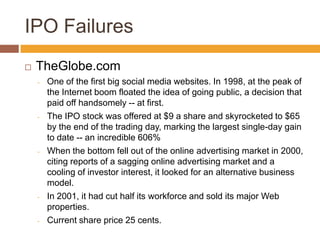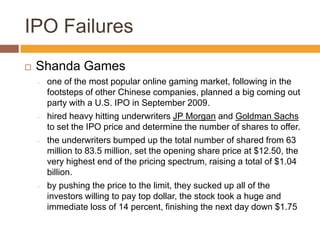Initial public offering(ipo)
- 1. INITIAL PUBLIC OFFERING(IPO) IPO AND ITS FAILURES
- 2. Initial Public Offering A type of public offering where shares of stock in a company are sold to the general public, on a securities exchange OR The first sale of stock (shares) by a private company to the public.
- 3. Reasons for IPO ’é© used by companies to raise expansion capital ’é© to possibly monetize/liquidate the investments of early private investors ’é© to become publicly traded enterprises ’é© enhance corporate image, thus providing visibility ’é© creating multiple financing opportunities: equity, convertible debt, cheaper bank loans
- 4. Process for IPO ’é© First thing ŌĆō hire an investment bank which acts as underwriter ’é© The company and the bank then meet to negotiate the deal ’é© Discuss how much amount of money a company will raise, the type of securities[preferred or common] to be issued
- 5. 1. Select an underwriter ’é© An underwriter is an investment firm that acts as an intermediary between a company selling securities and the investing public ’é© The underwriter is the principal player in the IPO ’é© Typically, the underwriter buys the securities for less than the offering price and accepts the risk of not being able to sell them
- 6. 2. Negotiating the deal ’é© Register with SEC [Securities and Exchange Commission] ’é© Red Herring ŌĆō Print prospectus describing details of issuing corporation and proposed offering ’é© Road-Show ŌĆō presented to institutional/potential investors allowing firms to raise interest and thus the price of shares
- 7. 3. Pricing and Selling ’é© The securities are priced based on the value of the company and expected demand for the securities ’é© Examples of valuation methods: ’éż NetPresent Value ’éż Earnings/Price ratios ’é© A full-fledged selling effort gets under way on the effective date of the registration statement ’é© A final prospectus must accompany the delivery of securities
- 8. Is it a good time to do an IPO? ’é© Determinants of suitability: ’éż The degree of urgency for financing your company ’éż The general stock market condition ’éż The industry market condition ’éż The frequency and size of all IPOŌĆÖs in the financial cycle
- 9. Financing New Ideas ’é© Personal savings ’é© Bank ’é© Government ’é© Large industrial companies ’é© Venture Capital Funds ’éż Mostly organized as private partnerships ’éż Need to prepare a business plan for funding ’éż They invest in stages to control risk ’éż They require board representation and get shares
- 10. IPO activity based on Demand/Supply ’é© Demand-side explanation: start-up firms with good projects cannot get private funding and they use IPO for raising capital ’éż Ifa hot issue period* is driven by demand-side for funds then it may be advantageous for a new firm to go public * hot issue period - A time period with a lot of IPOs
- 11. IPO activity based on Demand/Supply ’é© Supply-side explanation: during some time periods, investors and institutions that invest in IPOs have excess funds to invest ’éż Ifa hot issue period is driven by supply-side then a new firm may be better off delaying to go public - competition for funds
- 12. Factors to keep in mind before applying in an IPO ’é© Investors need to carefully go through the Red Herring(preliminary prospectus) and the final prospectus filed with the ROC ’é© Objects of the issues and its risk factors ’é© CompanyŌĆÖs & its Promoters track record in running a business ’é© Issue Price ’é© Capital structure of the company ’é© Tax benefits ’é© Any published reports that forecast the future earnings
- 13. Disadvantages of the IPO ’é© Expensive ’éżA typical firm may spend about 15-25% of the money raised on direct expenses[legal/marketing/accounting] ’é© Reporting responsibilities ’éż Public companies must continuously file reports with the SEC and the stock exchange they list on ’é© Loss of control ’éż Ownership is transferred to outsiders who can take control and even fire the entrepreneur cont..
- 14. Disadvantages.. ’é© Requirement to disclose financial and business information ’é© Meaningful time, effort and attention required of senior management ’é© Public dissemination of information which may be useful to competitors, suppliers and customers ’é© Risk that required funding will not be raised ’é© Market forces the company to sacrifice long term gains for short term profits
- 15. Alternatives to IPO ’é© Strategic partnerships ’é© Qualified Institutional Placement (QIP) ’é© Private Placement of Stock and Bonds ’é© Reverse Mergers ’é© Private Equity
- 16. IPO Failures ’é© TheGlobe.com - One of the first big social media websites. In 1998, at the peak of the Internet boom floated the idea of going public, a decision that paid off handsomely -- at first. - The IPO stock was offered at $9 a share and skyrocketed to $65 by the end of the trading day, marking the largest single-day gain to date -- an incredible 606% - When the bottom fell out of the online advertising market in 2000, citing reports of a sagging online advertising market and a cooling of investor interest, it looked for an alternative business model. - In 2001, it had cut half its workforce and sold its major Web properties. - Current share price 25 cents.
- 17. IPO Failures ’é© Shanda Games - one of the most popular online gaming market, following in the footsteps of other Chinese companies, planned a big coming out party with a U.S. IPO in September 2009. - hired heavy hitting underwriters JP Morgan and Goldman Sachs to set the IPO price and determine the number of shares to offer. - the underwriters bumped up the total number of shared from 63 million to 83.5 million, set the opening share price at $12.50, the very highest end of the pricing spectrum, raising a total of $1.04 billion. - by pushing the price to the limit, they sucked up all of the investors willing to pay top dollar, the stock took a huge and immediate loss of 14 percent, finishing the next day down $1.75
- 18. THANK YOU - Govind Ghiraiya

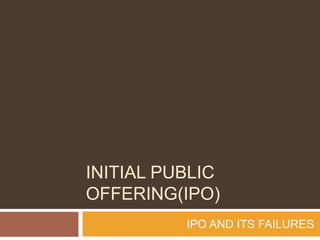

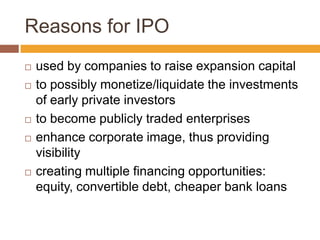
![Process for IPO
’é© First thing ŌĆō hire an investment bank which
acts as underwriter
’é© The company and the bank then meet to
negotiate the deal
’é© Discuss how much amount of money a
company will raise, the type of
securities[preferred or common] to be issued](https://image.slidesharecdn.com/initialpublicofferingipo-130214110230-phpapp02/85/Initial-public-offering-ipo-4-320.jpg)

![2. Negotiating the deal
’é© Register with SEC [Securities and Exchange
Commission]
’é© Red Herring ŌĆō Print prospectus describing
details of issuing corporation and proposed
offering
’é© Road-Show ŌĆō presented to
institutional/potential investors allowing firms
to raise interest and thus the price of shares](https://image.slidesharecdn.com/initialpublicofferingipo-130214110230-phpapp02/85/Initial-public-offering-ipo-6-320.jpg)

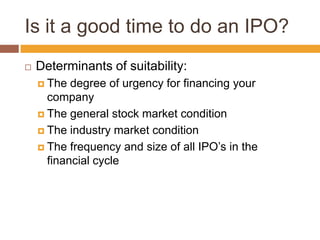



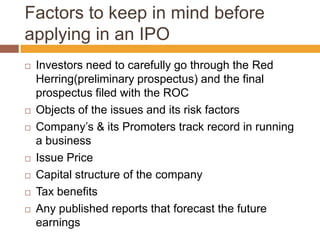
![Disadvantages of the IPO
’é© Expensive
’éżA typical firm may spend about 15-25% of the
money raised on direct
expenses[legal/marketing/accounting]
’é© Reporting responsibilities
’éż Public companies must continuously file reports
with the SEC and the stock exchange they list on
’é© Loss of control
’éż Ownership is transferred to outsiders who can
take control and even fire the entrepreneur
cont..](https://image.slidesharecdn.com/initialpublicofferingipo-130214110230-phpapp02/85/Initial-public-offering-ipo-13-320.jpg)


